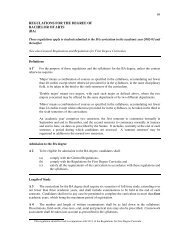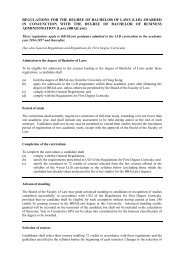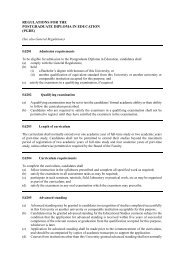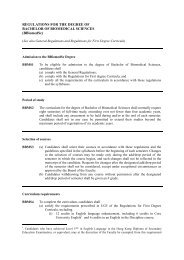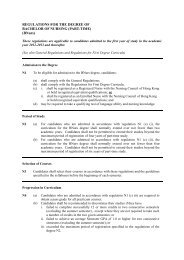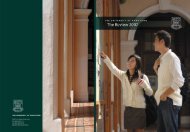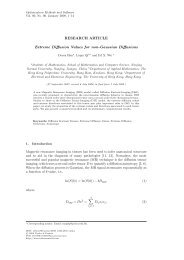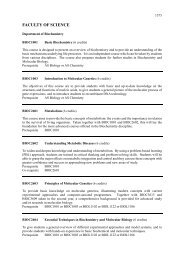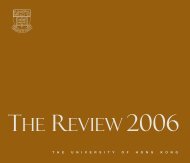(MBBS) (5-year-programme) - The University of Hong Kong
(MBBS) (5-year-programme) - The University of Hong Kong
(MBBS) (5-year-programme) - The University of Hong Kong
Create successful ePaper yourself
Turn your PDF publications into a flip-book with our unique Google optimized e-Paper software.
<strong>MBBS</strong> 1001Introduction to Health and Disease<strong>The</strong> Introduction to Health and Disease block is to provide an introductory overview <strong>of</strong> the structureand function <strong>of</strong> the human being, based around the theme <strong>of</strong> a “hierarchy <strong>of</strong> systems”. Through theuse <strong>of</strong> clinical case problems, students will explore the hierarchy <strong>of</strong> systems from molecules, cells,tissues, organs and major body systems to the patient as an individual, and as a member <strong>of</strong> a familyand a community. <strong>The</strong>y will examine the interaction between the different levels in the system, andso take a holistic view <strong>of</strong> human biology. <strong>The</strong> block also covers an overview <strong>of</strong> processes <strong>of</strong> disease,that is, the principle on how the physical, chemical and biological agents act at the tissue to molecularlevel to produce pathological processes such as inflammation, degeneration, neoplasia, autoimmunity,and gene malfunction which are final common pathways <strong>of</strong> cell damage or malfunction. It also givesthe introduction <strong>of</strong> therapeutic strategies for modulating disease processes.CAES1701English for Problem-based Learning in Medicine (3 credits)This course aims to enhance first <strong>year</strong> students’ English communication skills to enable them tomaximize the quality <strong>of</strong> their participation in problem-based learning discussions, and giveeffectively oral presentations in medical ethics seminars. It also comprises a medical terminologycomponent. Assessment is wholly by coursework.System-based Course<strong>The</strong> second semester <strong>of</strong> the first <strong>year</strong> and the two semesters <strong>of</strong> the second <strong>year</strong> is a system-based courseconcerning with the structure and function <strong>of</strong> the organ systems <strong>of</strong> the body in the context <strong>of</strong> the patientas an individual and as a member <strong>of</strong> a wider population group. Students are expected to acquire afundamental understanding <strong>of</strong> body systems in health and disease. <strong>The</strong> organ systems covered duringthese three semesters are respiratory, cardiovascular, gastrointestinal, urogenital, musculoskeletal,central nervous, head and neck, haematology/immunology, and endocrine.<strong>MBBS</strong>1003Cardiovascular system<strong>The</strong> objectives are to provide a basic understanding <strong>of</strong> the structure and function <strong>of</strong> the components <strong>of</strong>the cardiovascular system as well as the key concepts and terminology in anatomy, behavioural science,biochemistry, community medicine, microbiology, pathology, pharmacology and physiology that arerelevant to the cardiovascular system; to introduce common disease processes that affect thecardiovascular system; to ensure that an understanding <strong>of</strong> biological functions also takes into accountideas <strong>of</strong> the individual as a person, as a member <strong>of</strong> a family, and as a part <strong>of</strong> the greater community; toprovide a basic understanding <strong>of</strong> the role <strong>of</strong> the doctor, the functions <strong>of</strong> the health care system in <strong>Hong</strong><strong>Kong</strong>, and the relevance <strong>of</strong> medical ethics and economics to the practice <strong>of</strong> medicine; and to provide asupportive climate to students for the process <strong>of</strong> pr<strong>of</strong>essional development.<strong>MBBS</strong>1004Respiratory system<strong>The</strong> objectives are to provide a solid understanding and knowledge <strong>of</strong> the structure and function <strong>of</strong> therespiratory system as well as the mechanisms <strong>of</strong> common respiratory disease states and their treatment;to enable students to become aware <strong>of</strong> the public health issues e.g. cigarette smoking, environmentalpollution, primary health care, disease prevention, as they relate to the respiratory system; and tocultivate and foster the pr<strong>of</strong>essional development <strong>of</strong> students to become doctors responsive to the needs<strong>of</strong> the community as well as the individual patient.



